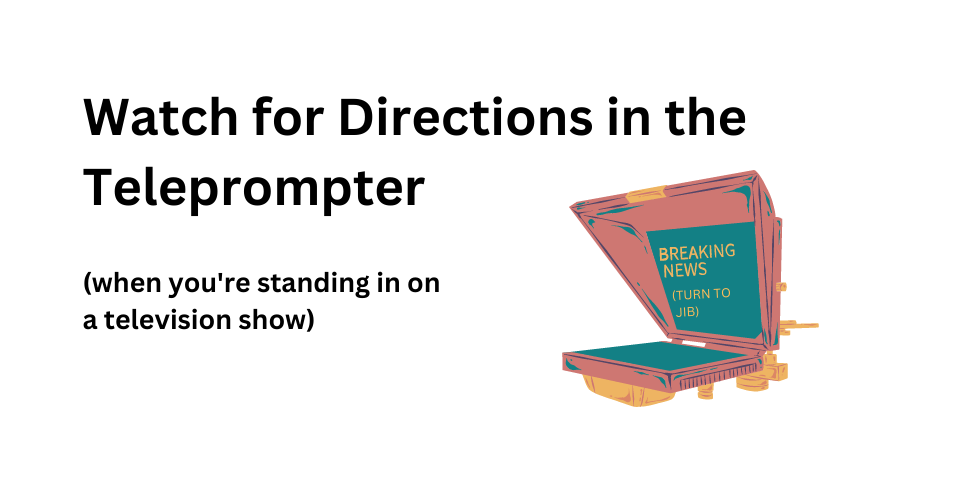Sometimes when you’re standing in on a TV show that shoots with a live audience, you may find you’ll be employed not only to stand on a mark, but also to read from a teleprompter.
The first time working with a teleprompter may be daunting. First, you have to remember your blocking, then the timing of your blocking, and now the timing of when you speak? Reading from a display of scrolling words??
Success may depend on your natural talent for reading aloud — or even depend on your eyesight — for determining how well you might do in working with a teleprompter. Cut yourself some slack the first time working with a teleprompter to gauge your general ability.
But look out in the teleprompter not just for the words you say, but also look for important actions you may need to do.
Here are some tips when it comes to directions in a teleprompter, when you’re standing in on a job that uses one.
Watch for Camera Directions
One of the more important directions you might see in a teleprompter is a camera turn.
You might see, “Turn to jib,” meaning at that point, turn to look at the camera on the jib (and read from its teleprompter if it has one).
Other times, you might see something like “Camera 1” or “Turn to Camera One” or even simply “Camera 1.” This, of course, would mean turning from your present camera to the camera named “Camera 1.”
Of course, this raises the question, “Which camera is Camera 1?” Most cameras on TV shows that shoot with live studio audiences number their cameras. Those cameras may or may not be obviously labeled as 1, 2, 3, etc. You may need to figure out the numbers of each camera when standing in in these situations, because making the right turn at the right time will help the director call and rehearse the shots.
Watch for Stage Directions
A teleprompter may give a simple direction like “Cross to …” and mention where on the stage you should cross. Obviously, do that when the time is right!
Or, a teleprompter may say when to grab a certain prop.
Generally, stage directions are short, because long stage directions take up a lot of screen, and you need the teleprompter for reading your lines aloud, not the stage directions.
Ask for Help When Needed
If you have contact with the person operating the teleprompter and you have a reasonable request about something on the teleprompter, don’t be afraid to ask for teleprompter help.
You may be miked up. If so, the teleprompter operator might be able to hear any request you ask if you directly ask it into your microphone. Otherwise, you can ask the stage manager for some help addressing a teleprompter issue you’re having.
Your feedback may be helpful for the operator to make sure the teleprompter is optimally set for the talent. In general, keep in mind that you’re there mainly to help the crew and eventually the talent for whom you’re standing in. If there needs to be a line break so you can see a new thought in the teleprompter better, or if a stage direction is so long it’s interfering with your read, politely say so and perhaps it will be addressed.
Avoid Rewriting
Writing or rewriting the script is not your job, so if you have a suggestion on what the teleprompter should say, just tread lightly. There are writers, and they may be responsible for what the teleprompter says. But a polite suggestion on a phrasing that might help you probably wouldn’t cause any harm.
Conclusion
All in all, look out for more than just words you say when standing in using a teleprompter. Keep a look out for stage directions, and follow them. If you don’t, it may render useless a rehearsal, especially problematic when rehearsal time is of the essence.
What tips do you have for teleprompter work when standing in? Share your advice in the comments below!







Leave A Comment